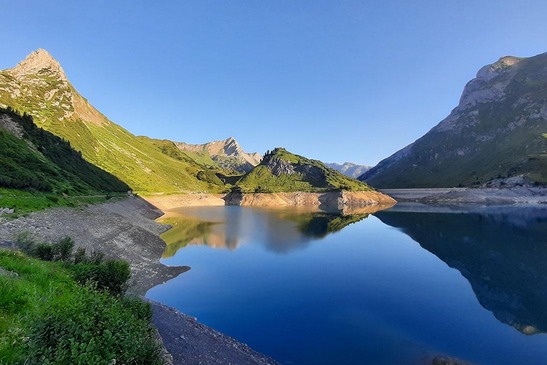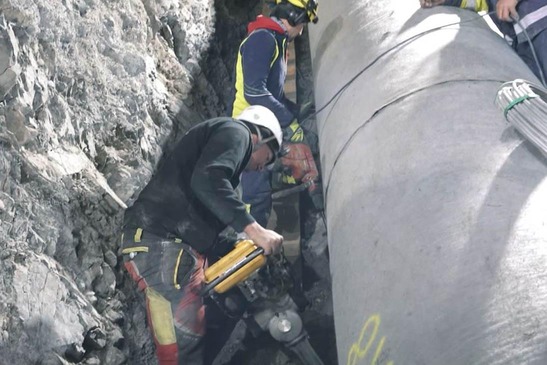
Thanks to the modern green energy centre, the traction power supply from 100 % renewable energy is ensured in the long term. This is not only good for the environment, but also for the guests who were able to attend the commissioning.
A mammoth project at a breathtaking height
The Spullersee power station was built by ÖBB between 1919 and 1925 as a traction power station. After almost 100 years of reliable, sustainable and environmentally friendly power generation, major parts of the plant had reached the end of their technical and economic life. In order to ensure the efficient generation of energy for the sustainable propulsion of trains in the future, the hydroelectric power plant was updated to state of the art over the past two years - the largest reconstruction in its power plant history - and thus "in time"!
Facts & Figures
-
- Power 36 MW
- Traction current 16.7 Hz
- Location: Lechquellengebirge, Vorarlberg
- Commissioning October 2021
- Project duration approximately 2 years
- Cost: approximately 31 m
-
Milestones
- Start of preparatory work: August 2019
- Start main works: July 2020
- Completion: December 2021
-
Contribution of Spullersee power plant after site optimisation: 12% of ÖBB's own standard capacity

Extreme conditions
Working day and night in 40 degree steep terrain, in snow, rain and heat and under special protective measures because of COVID-19, demanded a lot from the team. The trial run was the first touchstone, which was mastered with flying colours.
100 per cent renewable energy from Austria
Due to its structural design, the power plant is able to ensure the traction power supply for the whole of Vorarlberg together with the Braz power plant if required. The modern green power station can balance out load peaks from the traction power grid and also serves to ensure the stability of the ÖBB power grid. The Spullersee power plant therefore not only produces 100 per cent renewable energy from Austria, but also acts as a motor for the regional economy. In the West region (Tyrol and Vorarlberg), ÖBB also operates the Fulpmes power plant on the Ruetz in the Stubaital in addition to Braz and Spullersee. These three power plants produce around 220,000 megawatt hours (MWh) of electricity annually. In contrast, ÖBB's consumption in the two westernmost provinces is around 275,000 MWh, which corresponds to an annual consumption of around 55,000 households. ÖBB thus generates about 80 per cent of the required energy in the region itself, the rest is purchased from partner power plants and from the ÖBB Stubachtal power plant group.
Overview of the work carried out
-
Access tunnel / lake drainage / replacement of old gallery pipe
In winter 2019/20, the approximately 480-metre-long access tunnel was excavated as part of the new equipment concept. Parallel to this work, the Spullersee reservoir was emptied down to the original lake level at the beginning of January 2020. As part of this emptying of the lake, a new equipment chamber was excavated on the lake side and important mechanical engineering equipment such as two new butterfly valves suitable for emergency closure were installed. In an interim operating phase from May to June 2020, the meltwater in the catchment area of the reservoir was worked off. To protect the Arlberg railway line from the construction work, a protective enclosure was erected in advance (October 2019). The new, eight-tonne cable crane was erected under the protection of this enclosure. In addition, the old operating cableway and the three penstocks were removed. In mid-May 2020, the intake flap was closed and the old tunnel pipe made of steel from 1924 was replaced over the entire length of 1,750 metres by a newer, larger GRP pipe (glass-fibre reinforced plastic).
-
Old pressure pipelines replaced by underground steel pressure pipe
In the course of the main works, which started at the beginning of July 2020, a new, 1,460-metre-long, buried steel pressure pipe was constructed in place of the previous three pressure pipes. This steel pipe has a diameter of 1,100 mm and wall thicknesses of up to 25 mm. For the specialists, this work was highly challenging, as it had to be carried out on terrain with a gradient of up to 40°, summer and winter. The work on the penstock was completed in May 2021. Following this, the Spullersee power plant with 36 megawatts (MW) of expansion capacity was able to go into trial operation.


